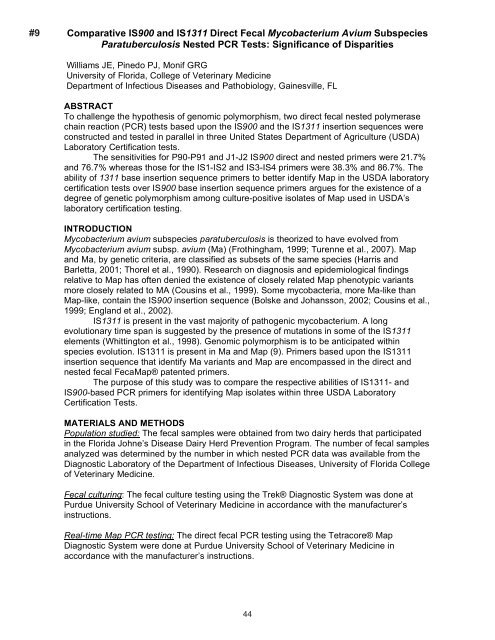Proceedings of the 10th International Colloquium on Paratuberculosis
Proceedings of the 10th International Colloquium on Paratuberculosis
Proceedings of the 10th International Colloquium on Paratuberculosis
Create successful ePaper yourself
Turn your PDF publications into a flip-book with our unique Google optimized e-Paper software.
#9<br />
Comparative IS900 and IS1311 Direct Fecal Mycobacterium Avium Subspecies<br />
<strong>Paratuberculosis</strong> Nested PCR Tests: Significance <str<strong>on</strong>g>of</str<strong>on</strong>g> Disparities<br />
Williams JE, Pinedo PJ, M<strong>on</strong>if GRG<br />
University <str<strong>on</strong>g>of</str<strong>on</strong>g> Florida, College <str<strong>on</strong>g>of</str<strong>on</strong>g> Veterinary Medicine<br />
Department <str<strong>on</strong>g>of</str<strong>on</strong>g> Infectious Diseases and Pathobiology, Gainesville, FL<br />
ABSTRACT<br />
To challenge <str<strong>on</strong>g>the</str<strong>on</strong>g> hypo<str<strong>on</strong>g>the</str<strong>on</strong>g>sis <str<strong>on</strong>g>of</str<strong>on</strong>g> genomic polymorphism, two direct fecal nested polymerase<br />
chain reacti<strong>on</strong> (PCR) tests based up<strong>on</strong> <str<strong>on</strong>g>the</str<strong>on</strong>g> IS900 and <str<strong>on</strong>g>the</str<strong>on</strong>g> IS1311 inserti<strong>on</strong> sequences were<br />
c<strong>on</strong>structed and tested in parallel in three United States Department <str<strong>on</strong>g>of</str<strong>on</strong>g> Agriculture (USDA)<br />
Laboratory Certificati<strong>on</strong> tests.<br />
The sensitivities for P90-P91 and J1-J2 IS900 direct and nested primers were 21.7%<br />
and 76.7% whereas those for <str<strong>on</strong>g>the</str<strong>on</strong>g> IS1-IS2 and IS3-IS4 primers were 38.3% and 86.7%. The<br />
ability <str<strong>on</strong>g>of</str<strong>on</strong>g> 1311 base inserti<strong>on</strong> sequence primers to better identify Map in <str<strong>on</strong>g>the</str<strong>on</strong>g> USDA laboratory<br />
certificati<strong>on</strong> tests over IS900 base inserti<strong>on</strong> sequence primers argues for <str<strong>on</strong>g>the</str<strong>on</strong>g> existence <str<strong>on</strong>g>of</str<strong>on</strong>g> a<br />
degree <str<strong>on</strong>g>of</str<strong>on</strong>g> genetic polymorphism am<strong>on</strong>g culture-positive isolates <str<strong>on</strong>g>of</str<strong>on</strong>g> Map used in USDA’s<br />
laboratory certificati<strong>on</strong> testing.<br />
INTRODUCTION<br />
Mycobacterium avium subspecies paratuberculosis is <str<strong>on</strong>g>the</str<strong>on</strong>g>orized to have evolved from<br />
Mycobacterium avium subsp. avium (Ma) (Frothingham, 1999; Turenne et al., 2007). Map<br />
and Ma, by genetic criteria, are classified as subsets <str<strong>on</strong>g>of</str<strong>on</strong>g> <str<strong>on</strong>g>the</str<strong>on</strong>g> same species (Harris and<br />
Barletta, 2001; Thorel et al., 1990). Research <strong>on</strong> diagnosis and epidemiological findings<br />
relative to Map has <str<strong>on</strong>g>of</str<strong>on</strong>g>ten denied <str<strong>on</strong>g>the</str<strong>on</strong>g> existence <str<strong>on</strong>g>of</str<strong>on</strong>g> closely related Map phenotypic variants<br />
more closely related to MA (Cousins et al., 1999). Some mycobacteria, more Ma-like than<br />
Map-like, c<strong>on</strong>tain <str<strong>on</strong>g>the</str<strong>on</strong>g> IS900 inserti<strong>on</strong> sequence (Bolske and Johanss<strong>on</strong>, 2002; Cousins et al.,<br />
1999; England et al., 2002).<br />
IS1311 is present in <str<strong>on</strong>g>the</str<strong>on</strong>g> vast majority <str<strong>on</strong>g>of</str<strong>on</strong>g> pathogenic mycobacterium. A l<strong>on</strong>g<br />
evoluti<strong>on</strong>ary time span is suggested by <str<strong>on</strong>g>the</str<strong>on</strong>g> presence <str<strong>on</strong>g>of</str<strong>on</strong>g> mutati<strong>on</strong>s in some <str<strong>on</strong>g>of</str<strong>on</strong>g> <str<strong>on</strong>g>the</str<strong>on</strong>g> IS1311<br />
elements (Whittingt<strong>on</strong> et al., 1998). Genomic polymorphism is to be anticipated within<br />
species evoluti<strong>on</strong>. IS1311 is present in Ma and Map (9). Primers based up<strong>on</strong> <str<strong>on</strong>g>the</str<strong>on</strong>g> IS1311<br />
inserti<strong>on</strong> sequence that identify Ma variants and Map are encompassed in <str<strong>on</strong>g>the</str<strong>on</strong>g> direct and<br />
nested fecal FecaMap® patented primers.<br />
The purpose <str<strong>on</strong>g>of</str<strong>on</strong>g> this study was to compare <str<strong>on</strong>g>the</str<strong>on</strong>g> respective abilities <str<strong>on</strong>g>of</str<strong>on</strong>g> IS1311- and<br />
IS900-based PCR primers for identifying Map isolates within three USDA Laboratory<br />
Certificati<strong>on</strong> Tests.<br />
MATERIALS AND METHODS<br />
Populati<strong>on</strong> studied: The fecal samples were obtained from two dairy herds that participated<br />
in <str<strong>on</strong>g>the</str<strong>on</strong>g> Florida Johne’s Disease Dairy Herd Preventi<strong>on</strong> Program. The number <str<strong>on</strong>g>of</str<strong>on</strong>g> fecal samples<br />
analyzed was determined by <str<strong>on</strong>g>the</str<strong>on</strong>g> number in which nested PCR data was available from <str<strong>on</strong>g>the</str<strong>on</strong>g><br />
Diagnostic Laboratory <str<strong>on</strong>g>of</str<strong>on</strong>g> <str<strong>on</strong>g>the</str<strong>on</strong>g> Department <str<strong>on</strong>g>of</str<strong>on</strong>g> Infectious Diseases, University <str<strong>on</strong>g>of</str<strong>on</strong>g> Florida College<br />
<str<strong>on</strong>g>of</str<strong>on</strong>g> Veterinary Medicine.<br />
Fecal culturing: The fecal culture testing using <str<strong>on</strong>g>the</str<strong>on</strong>g> Trek® Diagnostic System was d<strong>on</strong>e at<br />
Purdue University School <str<strong>on</strong>g>of</str<strong>on</strong>g> Veterinary Medicine in accordance with <str<strong>on</strong>g>the</str<strong>on</strong>g> manufacturer’s<br />
instructi<strong>on</strong>s.<br />
Real-time Map PCR testing: The direct fecal PCR testing using <str<strong>on</strong>g>the</str<strong>on</strong>g> Tetracore® Map<br />
Diagnostic System were d<strong>on</strong>e at Purdue University School <str<strong>on</strong>g>of</str<strong>on</strong>g> Veterinary Medicine in<br />
accordance with <str<strong>on</strong>g>the</str<strong>on</strong>g> manufacturer’s instructi<strong>on</strong>s.<br />
44






